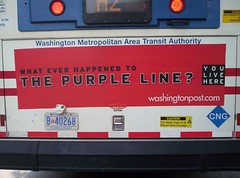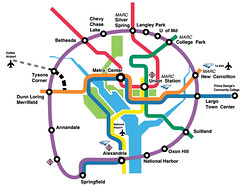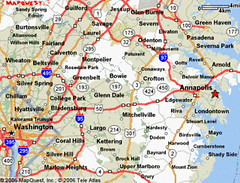Department of Duh: Washington Post edition (transit) (Updated)

________
Wonkette visitors: I invite you to check out this blog entry as well: Progressive City Leaders, Progressive Urban Politics and Policies (updated)
________
Today's Washington Post editorializes about the Purple Line, in "Going Purple." The editorial says the inner purple line is needed, and that elected officials aren't specific and supportive enough. This dovetails my point that us transit advocates need to lay out the ideal transit agenda, and keep it high up in the public eye.
The "Duh" comes in because the Post editorial ends with this sentence:
Both candidates [Ehrlich and O'Malley, candidates for Governor of Maryland] also need to recognize that additional transit -- namely, the Purple Line -- is critical to easing the region's traffic and sustaining its dynamic growth.
This after the Post, stalwart friend of the Growth Machine writes:
Mr. Ehrlich deserves credit for pushing a major road project linking Montgomery and Prince George's counties, the intercounty connector, which Mr. O'Malley also backs.
But I have to agree with the Post here:
The Purple Line, which would run parallel to the Capital Beltway, circumnavigating the region, is a classic example of a transit project whose obvious potential benefits to the region have been stymied by insistent local opposition.
In fact it's something I've been meaning to write about for the past few weeks. The virulent opposition by rich people with big houses in Bethesda should just be accepted. I'd rather say screw them, but likely without their virulence, this line would have been created 10 years ago. Change the alignment, and get moving. So they'll be stuck in their cars (at the same time, I'd say, no new investments in roads in their area). It'll be their problem and they'll deserve it.
Added: Although this breaks the rule of making great transit systems by satisficing: when you make bad routing and other decisions, you reduce the likelihood of use, which is why for example, that the buslines on Georgia Avenue or 16th Street in DC (but starting going to the Silver Spring metro station in Maryland) each have higher ridership just about than the 28 mile long Light Rail system in Baltimore and its suburbs.
Plus, you need to read the comments, one from me in response to Ben Ross, president of Action Committee for Transit, clarifying what I meant in the paragraphs above. I did write some about this in July and August 2005, in the blog entries "Maryland Matters" and "More about the intensification of land use." Also, just before I started blogging in earnest, I wrote about this article, "Fortunes Shift for East-West Rail Plan" from the Washington Post, about the decline of the fortunes of the Purple Line under the Ehrlich administration on the pro-urb national e-list (and I just popped into the comments of this entry, something I wrote in Nov. 2002 on the same subject, also extracted from the pro-urb archives).
 Sierra Club Metro DC- Challenge to Sprawl Campaign concept and graphic. (Although the originator of this concept is local journalist-artist Mark Jenkins, who suggested this in a City Paper cover story in the late 1980s.)
Sierra Club Metro DC- Challenge to Sprawl Campaign concept and graphic. (Although the originator of this concept is local journalist-artist Mark Jenkins, who suggested this in a City Paper cover story in the late 1980s.)Anyway, something not covered in the editorial is the opportunity this offers in being continued beyond New Carrollton to the Wilson Bridge, and out from New Carrollton to Annapolis.

Besides the Sierra Club, two other groups active in pushing the Purple Line forward are:
-- Prince George's Advocates for Community-based Transit
-- Action Committee for Transit (Montgomery County, MD)
Added: Bacon's Rebellion, a Virginia politics blog-website, also writes about the editorial, focusing on what they think of as "Another Cheap Shot from the Washington Post," about the Virginia Legislature being unwilling to fund transit through taxes. The entry isn't stupendous, although the point about funding transit in part by Urban Renewal Districts (he calls them "Community Development Areas") is a good one that captures some of the value produced by public investment. Portland did this with their "Interstate-Yellow MAX Line.
But the comments to the entry are pretty interesting (I have a long one in there myself) including a link to the dormant Virginia Capital Beltway Corridor Rail Study, which you can look at here: Conclusions and Recommendations (PDF); Executive Summary (PDF).
Index Keywords: transit



0 Comments:
Post a Comment
<< Home